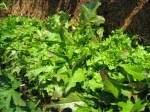 Lettuce is one of the most rewarding vegetables to grow. It is easy to grow from seed and takes very little room to grow. It grows best while the weather is cool so other crops can be planted in the same space after the first crop in the spring and before the second crop in the fall. If you lack garden space entirely, grow it in a pot, and if you choose different kinds of lettuce you can make up a very attractive container with variations in both texture and color.
Lettuce is one of the most rewarding vegetables to grow. It is easy to grow from seed and takes very little room to grow. It grows best while the weather is cool so other crops can be planted in the same space after the first crop in the spring and before the second crop in the fall. If you lack garden space entirely, grow it in a pot, and if you choose different kinds of lettuce you can make up a very attractive container with variations in both texture and color.
Here are the steps for a successful lettuce crop:
 Pick a suitable variety.
Pick a suitable variety.
There are hundreds of kinds of lettuce but they can be divided into 4 major groups: leaf (like Black seeded Simpson, loose head (open irregular heads like Bibb), Romaine (cylindrical head), and crisphead (solid head like Iceberg). Their days to harvest varies too; leaf is ready to pick in about 40-45 days, butter head in 65-80, folded in 70-80 days, and head in 80-95 days. You can be eating leaf lettuce in half the time it takes to grow head lettuce. If you like leaf lettuce, consider buying musclun, a variable mix of leaf lettuces.
 Provide good soil.
Provide good soil.
Lettuce needs fertile well-drained soil. Adding organic matter such as compost before planting helps both the fertility and moisture content of the soil.
 Plant at the proper time.
Plant at the proper time.
Plant in very early spring as soon as the soil can be worked. Lettuce does not like hot weather and seeds won’t even germinate when the soil is too warm. Alternatively, you can start seed indoors 4-6 week before the last frost in your area. In warm areas like southern California and Arizona, grow lettuce through the winter.
 Plant the seeds at proper depth and spacing.
Plant the seeds at proper depth and spacing.
Sow seeds of leaf lettuce ¼” deep and 1” apart in rows 18″ apart. Head lettuce needs more room so plan on rows 24” apart so the plants will form heads.
 Thin seedlings.
Thin seedlings.
Leaf lettuce should be thinned so that plants stand 3-4” part; head lettuce so plants stand 6-12” apart, allowing the larger figure for the crisphead lettuce.
 Mulch.
Mulch.
Put a light layer of mulch along the lettuce rows to conserve moisture and keep the lettuce free of dirt and mud splashed on it by rain or overhead watering. Gritty lettuce is hard on the teeth.
 Fertilize.
Fertilize.
Lettuce needs nitrogen to produce all those leaves so apply 10-10-10 every few weeks.
 Water
Water
Keep the soil evenly moist by applying water to a minimum depth of 4-5”. This may mean frequent watering during hot droughty times.
 Check for bugs and disease.
Check for bugs and disease.
Generally lettuce is pest free. In poorly drained soil, however, a fungus can cause the lettuce to rot; dry conditions can cause scorching of the leaves, and a variety of critters including rabbits, slugs to insects can eat the leaves.
 Harvest
Harvest
Begin enjoying your lettuce crop when you thin the plants. After that wait until each leaf lettuce plant has several leaves and snip off the outer ones. Many leaf lettuce plants can be cut to within an inch of the soil and the leaves will grow back quickly. For lettuce growing in heads, harvest when the centers feel firm when squeezed.
As the temperatures rise the lettuce may become bitter and eventually bolt. Wait till the end of summer and plant another crop as soon as temperatures cool off and you can get the lettuce seeds to germinate. Leaf lettuce is a good crop to share with children because its ease of culture and rapid growth to harvest.
